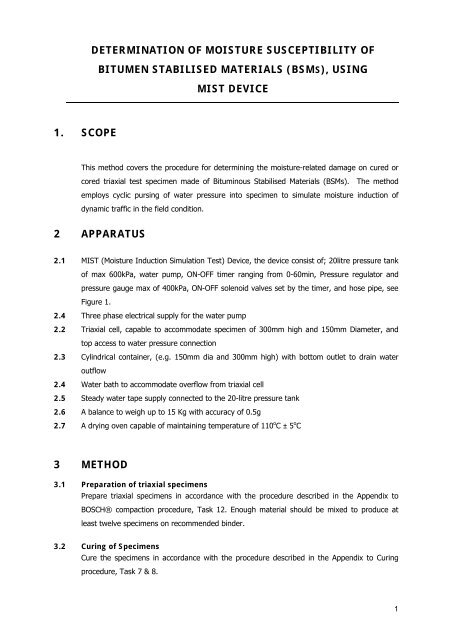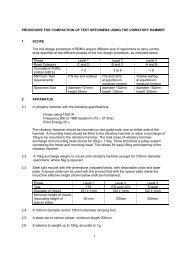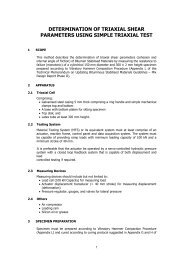Method 7. MIST Conditioning and Test Procedure - Asphalt Academy
Method 7. MIST Conditioning and Test Procedure - Asphalt Academy
Method 7. MIST Conditioning and Test Procedure - Asphalt Academy
You also want an ePaper? Increase the reach of your titles
YUMPU automatically turns print PDFs into web optimized ePapers that Google loves.
1. SCOPE<br />
DETERMINATION OF MOISTURE SUSCEPTIBILITY OF<br />
BITUMEN STABILISED MATERIALS (BSMS), USING<br />
<strong>MIST</strong> DEVICE<br />
This method covers the procedure for determining the moisture-related damage on cured or<br />
cored triaxial test specimen made of Bituminous Stabilised Materials (BSMs). The method<br />
employs cyclic pursing of water pressure into specimen to simulate moisture induction of<br />
dynamic traffic in the field condition.<br />
2 APPARATUS<br />
2.1 <strong>MIST</strong> (Moisture Induction Simulation <strong>Test</strong>) Device, the device consist of; 20litre pressure tank<br />
of max 600kPa, water pump, ON-OFF timer ranging from 0-60min, Pressure regulator <strong>and</strong><br />
pressure gauge max of 400kPa, ON-OFF solenoid valves set by the timer, <strong>and</strong> hose pipe, see<br />
Figure 1.<br />
2.4 Three phase electrical supply for the water pump<br />
2.2 Triaxial cell, capable to accommodate specimen of 300mm high <strong>and</strong> 150mm Diameter, <strong>and</strong><br />
top access to water pressure connection<br />
2.3 Cylindrical container, (e.g. 150mm dia <strong>and</strong> 300mm high) with bottom outlet to drain water<br />
outflow<br />
2.4 Water bath to accommodate overflow from triaxial cell<br />
2.5 Steady water tape supply connected to the 20-litre pressure tank<br />
2.6 A balance to weigh up to 15 Kg with accuracy of 0.5g<br />
2.7 A drying oven capable of maintaining temperature of 110 o C ± 5 o C<br />
3 METHOD<br />
3.1 Preparation of triaxial specimens<br />
Prepare triaxial specimens in accordance with the procedure described in the Appendix to<br />
BOSCH® compaction procedure, Task 12. Enough material should be mixed to produce at<br />
least twelve specimens on recommended binder.<br />
3.2 Curing of Specimens<br />
Cure the specimens in accordance with the procedure described in the Appendix to Curing<br />
procedure, Task 7 & 8.<br />
1
3.3 Evaluation <strong>and</strong> grouping of specimens<br />
3.3.1 After curing, remove the wet bag <strong>and</strong> let the specimens cool at ambient temperature (25 o C)<br />
for about one hour. Cover the specimens immediately if delay occurs for conditioning.<br />
After cooling, the following physical tests <strong>and</strong> measurements of each specimen carried-out:<br />
- The average height (t) <strong>and</strong> average Diameter (D)<br />
- Rice’s density (Gmm) in accordance with THM1 <strong>Method</strong> C4<br />
- Bulk relative density (Gmb) in accordance with THM1 <strong>Method</strong> C3<br />
- The specimen volume (E) as a difference in specimen weighed in water <strong>and</strong> specimen<br />
saturated surface-dry weight.<br />
- Percentage air void (Pa) in accordance with THM1 <strong>Method</strong> C3.<br />
3.3.2 Group the specimens into a set of two, with approximately equal void content (Pa). Separate<br />
these sets with six (6) specimens for wet conditioning <strong>and</strong> static (monotonic) test, <strong>and</strong> other<br />
six (6) for un-conditioning or dry static (monotonic) test.<br />
3.4 <strong>Conditioning</strong> of specimens<br />
3.4.1 Set-up the test variables on <strong>MIST</strong> device i.e. ON-OFF timer at 0.54sec load time, <strong>and</strong> 1.40sec<br />
rest period, <strong>and</strong> regulate pressure gauge at 140kPa cyclic pulsing water pressure. (Cyclic<br />
pressure might require adjustment to accommodate for the water momentum).<br />
3.4.2 Place specimen in a triaxial cell base <strong>and</strong> assemble the cell firmly. Then connect the top of the<br />
cell to the water pressure outlet, see Figure 1.<br />
3.4.3 Start the <strong>MIST</strong> device <strong>and</strong> count 100 cycles, or time the haversine cyclic pulsing for 3.2<br />
minutes then stop.<br />
3.4.4 De-assemble the triaxial cell, <strong>and</strong> remove the specimen carefully. Take weight of saturated<br />
surface-dry specimen <strong>and</strong> transfer the specimen to the triaxial static (monotonic) test set-up.<br />
3.5 Calculation<br />
Volume of air voids (Va) in specimen [cm 3 ],<br />
V<br />
Ρa<br />
xΕ<br />
=<br />
100<br />
= B −<br />
a<br />
Volume of water absorbed (Vw) in specimen [cm 3 ], Vw A<br />
Vw<br />
Degree of saturation (Sr) in specimen [%], s x100<br />
r V<br />
=<br />
Where:<br />
B = Weight of saturated-surface dry specimen [g]<br />
A = weight of dry specimen in air [g]<br />
Pa = air void content in specimen [%]<br />
E = volume of specimen [cm 3 ]<br />
3.5.1 The degree of saturation should be at least 80% for accurate screening of the BSMs.<br />
a<br />
2
3.6 Determination of retained cohesion ratio<br />
3.6.1 After conditioning, place the specimen into simple triaxial device set-up. Triaxial test is<br />
performed in accordance with the procedure described in the Appendix to Simple triaxial test<br />
protocol, Task 5.<br />
3.6.2 Two set of six (6) specimens with predetermined height <strong>and</strong> approximately equal void<br />
content, after conditioning are tested for static (monotonic) test at 50kPa, 100kPa, <strong>and</strong><br />
200kPa. Another two set of six (6) specimens tested unconditioned at 50kPa, 100kPa, <strong>and</strong><br />
200kPa, with the applied rate of loading of 2.1mm/minutes.<br />
3.6.3 Repeat test is done on the second set of six (6) specimens are done for statistical evaluation<br />
<strong>and</strong> repeatability.<br />
3.6.4 Shear properties (C <strong>and</strong> φ) of the conditioned <strong>and</strong> unconditioned sets of specimens are<br />
determined in accordance with the procedure described in the Appendix to simple triaxial test<br />
protocol, Task 5.<br />
3.6.5 Retained cohesion ratio is calculated as follows:<br />
Cohesion of wet mix, (CoW)<br />
Retained cohesion, (RC) =<br />
x100<br />
Cohesion of dry mix, (CoD)<br />
Where, cohesion of wet <strong>and</strong> dry mix calculated from Mohr Coulomb cycle as per Equation.<br />
Where,<br />
4 REFERENCES<br />
σ<br />
1,<br />
f<br />
1+<br />
sinϕ<br />
2.<br />
C.<br />
cosϕ<br />
= σ 3+<br />
1−<br />
sinϕ<br />
1−<br />
sinϕ<br />
σ1f = Maximum principal stress at failure [kPa]<br />
σ3 = confining pressure [kPa]<br />
φ = internal angle of friction of the mix [deg]<br />
C = cohesion of the mix [kPa]<br />
4.1 Appendix to Bosch® vibratory compaction procedure Task 12<br />
4.2 Appendix to Curing of BSMs procedure Task 7 & 8<br />
4.3 Appendix to Simple triaxial testing procedure Task 5<br />
4.5 THM1 <strong>Method</strong> C3, <strong>and</strong> C4<br />
3
Figure 1: <strong>MIST</strong> device features, set-up <strong>and</strong> connections<br />
4












